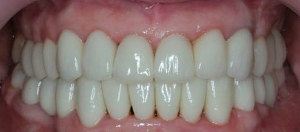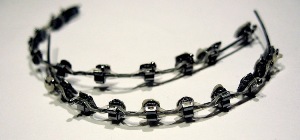 A modern, successful man monitors the health and beauty of his body. Sport, SPA, plastic surgery. But all this will not matter if the person has uneven teeth, a crooked smile or a bad pronunciation.
A modern, successful man monitors the health and beauty of his body. Sport, SPA, plastic surgery. But all this will not matter if the person has uneven teeth, a crooked smile or a bad pronunciation.
Bite is the location of the upper and lower dentition in relation to each other. The bite can be right and wrong - abnormal. The correct bite begins to form in infancy, during natural breastfeeding. Development continues in stages with the appearance of the first teeth and until adolescence.
When all the milk teeth are replaced by radical teeth - the bite becomes permanent and persists throughout the main part of a person's life.
How to form the correct bite in a child look in this video:
How to determine the right bite?
The person can determine the signs of the right bite by himself. You need to swallow saliva and fix the jaws in this position, then analyze the compatibility of the dentition.
 What should be the right bite:
What should be the right bite:
- the lower jaw is always behind the top;
- upper teeth cover 1/3 of the bottom;
- if you mentally draw vertical lines through the centers of both jaws, they must coincide;
- upper molars must touch the lower teeth.
Species of normal bites
Specialists define several types of the right occlusion:

On the photo the ideal bite
- Orthognathic .If the upper row of even teeth covers the lower one no more than 30%.Orthodontics is considered to be the ideal type of bite. It occurs very rarely. Maximally functional and beautiful from an aesthetic point of view.
- Direct .It differs from orthognathic only in the degree of covering the upper row of teeth above the lower one. In this type of bite, the incisors touch each other in the process of chewing food, which contributes to their quick abrasion.
- Progenic is specified in that the bottom row of teeth is slightly pushed forward and is at the level of the top. All teeth are tightly closed.
- Biprognatic is the type of right occlusion when the upper and lower teeth are slightly inclined forward. This form is particularly clear when seen from the side.
- Opisthognatichesky .The difference with the previous type of bite is that the teeth are slightly inclined not outward, but inward. The front teeth from the side look too straight.
Deviations from the norm
Also the types of abnormal bite are distinguished by the physicians:
- Prognathic ( distal).The upper jaw protrudes strongly towards the underdeveloped lower jaw.

- Mesional .The lower jaw protrudes somewhat forward. Forms a "manly" chin.
- Open .Most teeth do not close with it. It is divided into the frontal( in the photo on the left) and lateral, depending on which teeth do not connect with each other.
- Deep .The front teeth of the upper jaw cover the lower teeth by more than 60%.Dangerous that the chewing process injures the palate and the gums.
- Cross .The dentition rows of both jaws cross each other diagonally. In connection with this, it is often called a "scissors bite".
- Reducing is formed due to friction of the teeth against each other and their gradual abrasion( scratching teeth) or when several teeth are lost.
The difference in normal bite and abnormal may be imperceptible to an unsophisticated look. It is best to ask about this at a dentist's appointment. Perhaps he will give direction to an orthodontist - a doctor who specializes in bite problems.

In the photo, the options for a proper bite of teeth
Correct bite is useful and pleasant. Firstly, it is a beautiful smile and a correct contour of the face. Secondly, this is the absence of speech defects. Thirdly, with the right bite, there will be a proper chewing on the food. As a consequence - good digestion and normal operation of all related systems of the body.
In this case, it is important not only the mutual arrangement of the teeth relative to each other, but also the even teeth. If the jaws are not correctly closed, a greater strain on the temporal joint occurs. There is no relaxation of the jaw muscles, which can cause permanent headaches.
 If another 25-30 years ago to change the bite it was possible only for a child up to 15-16 years old, now there are ways to correct the occlusion at any age. Bracket systems, kapy - are not traumatic methods, but rather long-term effects.
If another 25-30 years ago to change the bite it was possible only for a child up to 15-16 years old, now there are ways to correct the occlusion at any age. Bracket systems, kapy - are not traumatic methods, but rather long-term effects.
Surgical methods and prosthetics for bite correction are currently used much less often. Therefore, an incorrect bite is not a verdict in the modern world.
